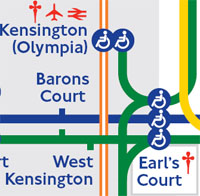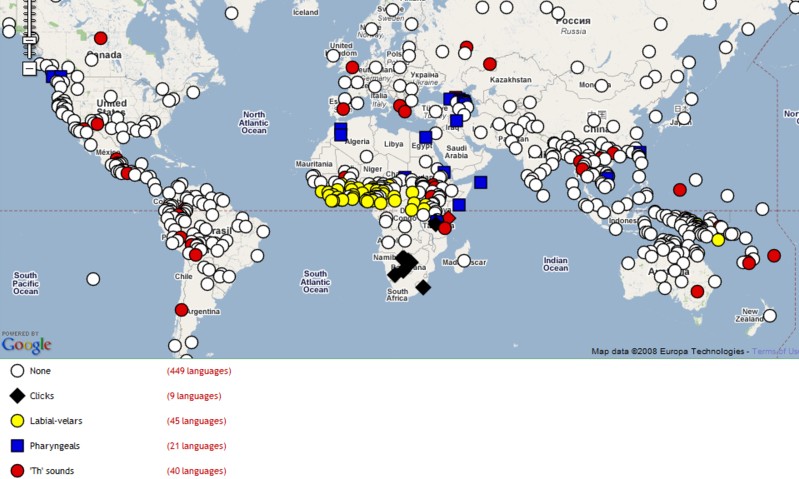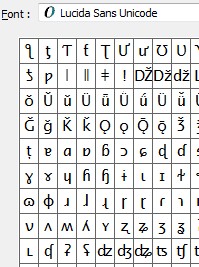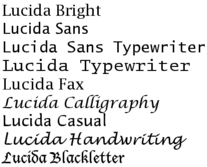DEPARTMENT OF SPEECH, HEARING & PHONETIC SCIENCES UCL Division of Psychology & Language Sciences |
 |
|
|
John Wells’s phonetic blog archive 1-15 May 2008To see the IPA phonetic symbols in the text, please ensure that you have installed a Unicode font that includes them all, for example Lucida Sans Unicode or Charis SIL (click name for free download). Browsers: I recommend Firefox (free) or, if you prefer, Opera (also free). email:
|
Thursday 15 May 2008 | BrE and AmERichard Rosser writes I teach English at a teacher training college in Rotterdam where we train teachers for further education in all the mainstream school subjects. My particular responsibility is phonetics, British culture and to some extent the history of the language — all fascinating stuff — and it is a privilege to work with young ambitious students. The Dutch have always been at the forefront as foreign learners of English and RP has been the standard here for many years. This is now coming under pressure from GA (among others) and we are slowly being faced with the fact that we shall have to let RP go, that is if we want any of our students to graduate. I should be interested in any comments that teachers at training colleges in other European countries may have and how they are coping (or not) you may have on what I see as a problem. Could you put this on your blog and see if anyone reacts at all ? I should also of course be interested in any observations you may have. This is a difficult issue, and one people often ask me about. The first thing I usually say is that it is much more important to concentrate on the common phonetic core of all kinds of English than to worry about the minute details of this or that model. First you have to get a good grasp of such matters as
Only when those are all thoroughly under control should you start worrying about whether to take British or American or some other kind of English as your model. And let’s face it, for most learners of EFL they are not all thoroughly under control. Second, the ideal circumstances for learning to pronounce English are when the learner has a close relationship with a single native speaker or a group of NSs. If you are lucky enough to be in that position, imitate what you hear.Your NS friend or colleague can operate in any kind of English-speaking environment, so if you are like them you will be able to too. (In my time I have met a German who sounded as if he came from Essex, a Japanese who sounded as if he was Texan, and a Korean who sounded like an upper-class Indian. I consider all three to be highly successful learners of English pronunciation, even though none of them pronounced in exactly the way any textbook prescribed.) However, that does not altogether address the question as put by Mr Rosser. I’ll return to the matter tomorrow. |
|
Wednesday 14 May 2008 | On the trainMasaki Taniguchi has sent me a recording made aboard a train from Canterbury to London. Here is a fragment of the announcement made by the train manager to the customers (or, as we used to say, by the guard to the passengers). |
Tuesday 13 May 2008 | Phonetic numeralsMany people are familiar with the NATO/ICAO “phonetic alphabet” (alfa, bravo, charlie, delta, echo, foxtrot...). In fact in LPD I list these ‘communications code names’ under each alphabetic letter. Nigel Greenwood points out that in the NATO/ICAO scheme it is not only the letters that are supposed to be pronounced in specified ways, but also the numbers. Their pronunciation is indicated by respellings, hopefully to avoid any confusion. The two best-known special pronunciations are fife for ‘five’ and niner for ‘nine’ -- a sensible way to avoid confusion between the two over a crackly radio channel. But one confusing respelling is fower for ‘four’. In discussion of this recommended pronunciation people tend to assume that it’s meant to rhyme with "flower" (perhaps because it's immediately preceded by "tree"). Nigel continues In fact, though, I presume this respelling originated in an attempt to train people to say something like ˈfəʊə rather than the monosyllabic, non-rhotic fɔː. I very much doubt whether it was intended that radio operators should actually say ˈfaʊə. The question, then, is whether "fower" is meant to rhyme with flower, tower or rather with grower, mower. Fower seems also to be the Scots dialect spelling for four. Perhaps someone can tell us what this means phonetically. An instructional CD-ROM I have (the excellent "VFR RT Communications", produced by Oxford Aviation Training) pronounces the word ˈfaʊə when introducing the pronunciations in isolation -- but then goes on to pronounce 4 in the usual way [i.e. fɔː] in examples of actual transmissions. Some speakers on the CD do make more of an effort to say ˈfəʊə during transmissions, it's true; but none goes so far as to say ˈfaʊə. All this confusion could have been avoided if only the NATO people had used IPA to describe what they meant! But then pilots aren't trained to read IPA ... Or they might even have asked a phonetician to advise on making respellings unambiguous. |
Monday 12 May 2008 | Pea's, plea'sA few days ago I was invited to take part in a radio discussion on the topic of the apostrophe. Its use or misuse is something of an obsession of the kind of listener who likes to bemoan the deteriorating standards of the younger generation, in this case their failure to master the principles of English spelling and punctuation. The question that had arisen was the correct spelling of expressions like sports day / sport’s day / sports’ day. There were three of us ‘experts’ being interviewed. We all agreed that we need no apostrophe in sports day, since it is a day for sports, not a day of a sport or a day of sports. Going further, somewhat to my surprise, we all agreed that possessive apostrophes could well be entirely banished from English spelling. Since we do not distinguish boys, boy’s, and boys’ in speech (all are bɔɪz), there should be no need to distinguish them in writing. I pointed out various inconsistencies in current usage such as the adjacent stations in the London Underground officially spelt Barons Court and Earl’s Court respectively. When I was a boy people quite often still wrote ’bus and ’phone, to show that these were shortenings of longer words. No one does that any more. Well, hardly anyone. It is clear that the rules for using the apostrophe are quite difficult for people to learn. Although they may seem quite straightforward to the linguistically sophisticated, you only have to observe public signs or internet postings to see that the rules are nevertheless problematic for many people. Other than confusion of its and it’s the commonest error is actually the overuse of the apostrophe — the “greengrocer’s apostrophe” as when banana’s and avocado’s are offered for sale. See my pictures of a fish and chip shop window, taken this weekend. (The signwriter probably thought that an apostrophe was necessary for the plural of any noun ending in a vowel sound.) The only apostrophes we really do need, I suggested, are those in the contractions he’ll, she’ll, I’ll, we’ll, since otherwise they could be misread as hell, shell, ill, well. Other than that, we can do without. |
|
Friday 9 May 2008 | Instances and incidencesIt is sometimes very difficult indeed to hear the difference between instances and incidences. That is why some people confuse the two words. Here are a few cases thrown up by Google. New incidences of human rights abuses in run-up to the Beijing olympics revealed (Amnesty International) What incidences of racism have you ever had to personally deal with? (Yahoo Answers) Could you please supply me with any information/documents concerning how many incidences of assault between prison inmates at HMP Liverpool have occurred dating from January 1 2000. (The UK Home Office) In each case the writer must surely have meant instances. (Alternatively, in the last case they may have meant incidents. We’ll talk about the possible homophony of incidence and incidents on some other occasion.) The confusion arises because instance and incidence may be pronounced identically in rapid speech. This is because of the possible disappearance of the vowel of the middle syllable of incidence. We can, and often do, go straight from the s to the d, omitting the weak vowel (ə, or a conservative ɪ) that would otherwise stand between them. Since under these circumstances the d, now abutting on a voiceless consonant, gets devoiced, the result is that the -sd̥- of incidence ends up very similar to the -st- of instance. In moderately-paced speech the deleted vowel seems to leave some compensatory lengthening of the preceding consonant: ˈɪn(t)sːd̥ən(t)s. In rapid speech, however, I think this subtlety of timing can be lost, making incidence as good as homophonous with instance. At UCL some of us at one time called this phenomenon ‘pseudo-elision’, as opposed to true elision where the deleted segment supposedly leaves no trace at all. We find the same thing in words such as trinity, comedy, Cassidy, quality, university (can it rhyme with thirsty?). In trinity the tongue tip may remain in place on the alveolar ridge as we pass from the (lengthened?) [n] to the [t], with no intervening vowel. |
|
Thursday 8 May 2008 | Barred i (?)Here’s another email question I’ve been asked. (This correspondent does not tell me anything about himself other than his name. His email address does not reveal his location. It would have been helpful if he could at least have indicated whether he is a native speaker of English, or if not then of what language.) | |
|
| ||
|
The figure-one character, [1], is the SAMPA equivalent of ɨ, barred-i. But that is not what we see in the cited pronunciations of predication, as in my screenshot of the email. Here we see not lower-case barred-i but lower-case barred-small-cap-i. (I cannot display this symbol in text since it has only recently been assigned a Unicode number, U+1D7B, and is not found in any of our usual phonetic fonts, only in Code 2000.) There’s another mystery with this enquiry. The transcriptions in the second edition of the OED do not use any such symbol, nor do those on the OED word of the day site. The citation must have been taken from some other source. That source is not the Oxford Advanced Learner’s Dictionary, either. It must be the Oxford Dictionary of Pronunciation, or some other work drawing on the same database. I replied In the ODP, the barred small-cap I is merely an abbreviatory convention meaning ɪ or ə. See page x of the introduction to the ODP. So you can pronounce the vowel in either of those two ways. Barred small-cap I is not an official IPA symbol and therefore not represented in (X-)SAMPA. The SAMPA symbol [1] stands for a lower-case barred i, ɨ, which is used in the transcription of Russian and various other languages, including northern varieties of Welsh. But what really worries me is this: how come the enquirer feels he has to write to me instead of asking his teacher? It also seems strange that the teacher should reportedly be using ɨŋ to transcribe (presumably) the English ending -ing. I would want to ask the teacher about that myself. | ɨ | |
Wednesday 7 May 2008 | The happY vowelI get quite a few emails from readers asking questions about phonetic matters or asking me to deal with a particular topic. There are too many to deal with them all, but I try to cover them as far as I can. Andrea Casareski wrote: Hi! I'm an Argentinian English teacher who loves phonetics. I must admit I'm becoming an addict to your blog and I recommend it to whoever happens to mention the word phonetics, even by chance! As a Teacher Training College student, some ten years ago, I was never told that there was a vowel called "happy i". Now that I'm a teacher trainer I come across that item very often and it worries me because of the fact that I can't find any theory related to the topic which can clearly explain its use. I'd love to read about this issue in your blog. Here’s a brief answer: The point is that the last vowel in happy and all other similar words can be like the iː of fleece or like the ɪ of kit or something intermediate between them. The distinction between iː and ɪ is “neutralized” in this environment. There are many thousands of other examples besides happy — very, coffee, valley, spaghetti, sanity, suddenly; also the second vowel in various, radiation. Current pronunciation dictionaries and other works use the notation i to show these cases where the distinction does not apply. Where it does apply, they write iː (as in green, bead, feet, reach, seating), and ɪ (as in grin, bid, fit, rich, sitting). Please read about this in LPD in the panel on Neutralization, or in my Accents of English section 2.2.25. See also Jack Windsor Lewis’s blog entries for 10 Nov 2006 and 3 Jan 2007. There is a corresponding back vowel u, as in thank you, incongruous, situation. More technically, it seems to be right to recognize two distinct vowel systems in English. The strong system (in RP) covers ɪ e æ ɒ ʌ ʊ iː eɪ aɪ ɔɪ uː əʊ aʊ ɪə eə ɑː ɔː ʊə ɜː, while the weak system covers not only i u ə but also ɪ ʊ, as in finishes, executive. Weak vowels occur only in unstressed syllables, although strong vowels may be either stressed or unstressed. The vowels ɪ ʊ therefore belong to both systems. As a weak vowel, however, ʊ is increasingly replaced by ə. Various other accents, e.g. Australian, lack the distinction between weak ɪ and ə, or at least give it a very low functional load. Thus English seems to be moving towards a weak system of three vowels only: i u ə. Vowel weakening involves a switching between the strong system and the weak system. We see this
One of the reasons our spelling system is less than transparent is that it generally writes the strong and weak alternants identically. The happY vowel is good news for speakers of languages such as Spanish, for whom the distinction between iː and ɪ is difficult. Where we write i, they needn’t bother to make that distinction. |
|
Tuesday 6 May 2008 | Lucida and the history of typographyCharles (Chuck) Bigelow writes It's wonderful that the name of our typeface has inspired your elegant discussion. (blog, 1 May). He confirms that he and Kris Holmes pronounce it just like lucid plus a final schwa. He continues Most Americans, when they say the name in my hearing, pronounce it the same way, though some scholars, like Pierre MacKay — classicist, Turkish and Arabic scholar, and typographer — end it with a more romantic [a]. And, of course, our Spanish colleagues pronounce it as you have described, choosing the position of the stress depending on which shade of meaning they think may be intended. Such subtlety, however, goes beyond our modest philological intentions. I should let you know that another version of the Lucida Sans design has been released with a larger set of Unicode phonetic characters, in both regular and bold weights. It includes the IPA and related characters, as well as polytonic Greek, Uralic phonetic characters, and others. The name change, mainly a marketing distinction desired by Apple, will no doubt raise the question of how "Grande" is pronounced in "Lucida Grande". Is the final e silent, [e], or [ə]? An historical aside: Because Lucida was designed to optimize legibility in early laser printing and computer screen display, we wanted to give it a name that could suggest it was made of light and was clear despite the low resolutions of screens and printers at that time, but we didn't want the name to be a mere description. "Lucidus" or Lucido" might have been fine, but the success of Futura, Optima, and Helvetica led us to consider a name ending in the Latin feminine singular. Maybe it was just superstition that a name could influence popularity. I was interested in your remarks about other phonetic fonts, and would welcome any criticisms you might wish to make about the newest Lucida Grande phonetics. If you use a Windows PC, you can get them by downloading Safari for Windows. (Except, I don't see the download for Windows XP option on the Apple site at the moment.) He signs himself Chuck Bigelow. I would say how interesting it is to hear this straight from the horse’s mouth, if that didn’t sound rather disrespectful. |
|
Monday 5 May 2008 | As you may have guessed from my reference to Facebook last week, I have recently been digging around on this rather addictive website. I have actually been a member for over a year, having been recruited by members of my running club who belong to it and by the faculty IT advisor at UCL. But only now have I been exploring some of my various other connections. Each of us represents a unique intersection of a number of different human networks, groups, and interests. Facebook brings these all together, since it has the potential of delivering a steady stream of information from the other members belonging to each of your particular networks, groups, or interests. I’ve already mentioned the Facebook group Phonetics is the new Rock n' Roll. Go to its page (I think you have to be a member of Facebook to do this) and you will currently see on the screen a photo of Peter Ladefoged advising Rex Harrison about playing Professor Higgins, as well as snapshots of Peter Roach, A.C. Gimson and Daniel Jones. (It appears that this group was set up by students of Ken Lodge at the University of East Anglia.) There are several other groups relevant to phonetics.
The way it works is this. Once someone is on Facebook you can invite them to be one of your friends, or equivalently you can accept their invitation to be one of their friends. Thereafter you will be able to see any information they post on Facebook, and they will see yours. Joining a group means you see information posted by members of that group. So I can report that one of my academic phonetic colleagues was recently taken out to dinner by her lovely husband (who's paying), but is now vegging out, having prepared and eaten a vast roast dinner; that one of my former students has dyed her hair; that a former course member of SCEP (of which there are quite a few on Facebook) has become interested in Jane Austen; and that a certain Frenchman has just lost his girlfriend. This last one is linguistically interesting, because he first reported the news in Esperanto, before getting his relationship status updated in English. So first he wrote
and then a little later his profile changed to show
The first message includes a very good example of the agglutinative nature of Esperanto morphology. The word senkaruliniĝis is made up as follows: kar|a ‘dear’ (adjectives end in -a) This agglutinative structure has the advantage of drastically reducing the burden of vocabulary learning for the language learner, while being a flexible and inventive resource for those who can manipulate the language. If you need to express a concept, you can just build it up out of known morphemes with constant form and meaning. On the other hand it has the disadvantage of making sentences harder to understand for those who have never studied the language and imagine that mere knowledge of French, Italian or Spanish will suffice to work out what something means. |
|
Friday 2 May 2008 | World atlas of language structuresNo sooner had I posted the discussion of the number of sounds in the world’s languages (30 April) than Language Log passed on the good news that you can now access the World Atlas of Language Structures on-line. You can read the entire text of each chapter and look at all the maps. Here’s one of them, “Presence of uncommon consonants”. | |
|
| ||
Here are some quotations discussing the number of different consonants and vowels in languages. The range of resulting inventories extends from a low of 6 consonants to a high of 122. Rotokas (West Bougainville; Papua New Guinea) has only six consonants. These might be represented in a simplified transcription with the letters /p, t, k, b, d, g/ although the range of pronunciations heard in different word positions covers a considerably wider range of sounds than these letters suggest. !Xóõ (Southern Khoisan; Botswana) has 122 consonants, mainly because it has a very large number of different click sounds with which a word may begin. The more typical consonant inventory size is in the low twenties, with the mean for the 562 languages being 22.7, the modal value 22 and the median 21. The average number of vowels in a language is just fractionally below 6. The smallest vowel quality inventory recorded is 2 and the largest 14. There are 4 languages in the sample with only two contrasting vowel qualities; these are languages in which only the height of the vowel has any distinctive function according to at least one possible interpretation of their phonetic patterns. An example of this extreme is Yimas (Lower Sepik-Ramu; Papua New Guinea). Only one language in the sample, German, uses 14 vowel qualities and only 2 make use of 13, namely the variety of British English included here and Bété (Kru, Niger-Congo; Côte d'Ivoire). Considerably more languages have an inventory of five vowels than any other number - 188 or just over one-third. The next most frequent inventory size is six vowel qualities. Fascinating stuff (to me, at least). Charles Bigelow tells me that he and Kris Holmes (the designers of the Lucida typeface) pronounce it ˈluːsɪdə, just like lucid plus a final schwa. Frankly, we don't object to any of the pronunciations. We're just glad to hear that people are using it. Emily Hitz tells me that LOLspeak (blog, 29 April) is based largely on "Leet". In Wikipedia there is an incredibly long article about it. Kel Miller can’t decide whether LOLspeak is an interesting phenomenon or a horrifying abomination. What's shocked me the most, however, is the Bible translation project, it shows the scope of LOLspeak. One intriguing aspect of Leet is its advocacy of the use of IPA symbols to write things upside down. ·əɼdɯɐxə uɐ sˌəɹəɥ | ||
Thursday 1 May 2008 | How do you say Lucida?No pronunciation dictionary includes the font name Lucida. I didn’t even think of putting it in LPD3. But two people have recently asked me how it ought to be pronounced. Actually, Lucida is not the name of a single font but rather of a family of fonts: hence the names Lucida Sans Unicode, Lucida Grande, etc. They were designed by Charles (‘Chuck’) Bigelow and Kris Holmes in 1985. The question is whether we should say ˈluːsɪdə (or with lj-), just like lucid plus a final schwa; or whether it should be luːˈsiːdə or even a great-vowel-shifted luːˈsaɪdə or an Italianate ˈluːtʃɪdə. As an Italian word, meaning ‘shining, lucid’ (f.), lucida is indeed ˈlutʃida. Spanish has both lúcida and lucida, again feminine adjectives, with slightly different meanings. The first is ˈluθiða, ˈlusiða and the second luˈθiða, luˈsiða. However, we are talking here about English, not Italian or Spanish. And in English we look to Latin. English lucid is taken from the Latin adjective lūcĭdŭs. Since the penultimate i is short, the regular Latin stress rule means that stress goes on the antepenultimate, the lū-. Dropping the masculine ending ‑ŭs, as is usual, yields English ˈl(j)uːsɪd. The feminine form of the adjective is lūcĭdă, with the same stress. Keeping the feminine ending, we would get ˈl(j)uːsɪdə. There are no other English words ending -ida that might provide an analogy, except perhaps in a learned singular of such zoological taxonomic terms as Psittacidae, Vespidae, Ovidae, all with antepenultimate stress. The penultimate-stressed armada and pagoda do not provide models. The first comes via Spanish from the Latin feminine past participle armāta, with a long penultimate vowel and therefore penultimate stress. The second is from Portuguese, “probably ultimately from Persian butkada ‘idol temple’” (COD) and so not Latin-derived. I am attempting to contact Prof. Bigelow to find what he thinks. [PS: see what he said in my blog posting for 2 May and now 6 May.] Meanwhile, I vote for ˈluːsɪdə. Hello? Tristan McLeay of Melbourne thinks he normally pronounces hello (blog, 28 April) as hæˈləʊ. He claims that most or all Australians spell the word as hello and pronounce it correspondingly with he‑. However in Victoria e is lowered to æ before l, which makes celery-salary and shell-shall homophones. (Compare David Deterding’s idiolect, blog 1 Nov. 2007). Hence hæˈləʊ. Tristan continues The Macquarie Dictionary lists hʌ‑, hə‑. I'm not sure I've ever heard an Australian use the former pronunciation. I would've expected it to list he‑. My own rather ancient (1981) copy of Macquarie, the standard dictionary of Australian English, confirms these prons but lists all three spellings hallo, hello, hullo. |
|
Blogroll links:
- DCblog (David Crystal)
- Language Log (Mark Liberman, Geoff Pullum et al.)
- John Maidment
- Linguism (Graham Pointon)
- PhonetiBlog (Jack Windsor Lewis)
Archived:
To search my web pages, use this Google search.
















